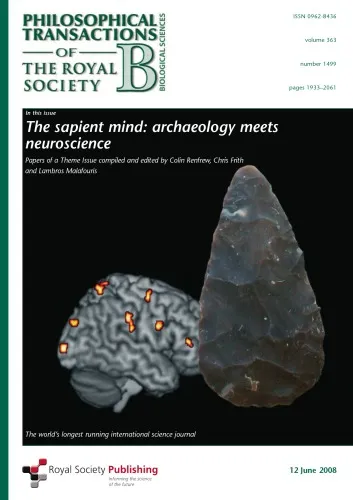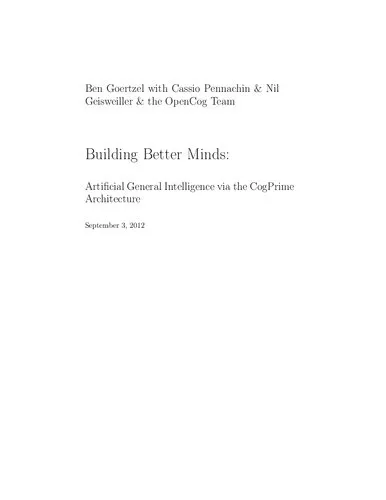The Sapient Mind: Archaeology Meets Neuroscience (Philosophical Transactions of the Royal Society B)
4.3
بر اساس نظر کاربران

شما میتونید سوالاتتون در باره کتاب رو از هوش مصنوعیش بعد از ورود بپرسید
هر دانلود یا پرسش از هوش مصنوعی 2 امتیاز لازم دارد، برای بدست آوردن امتیاز رایگان، به صفحه ی راهنمای امتیازات سر بزنید و یک سری کار ارزشمند انجام بدینکتاب های مرتبط:
مقدمهای بر کتاب 'The Sapient Mind: Archaeology Meets Neuroscience'
در دنیای پیچیده و به سرعت در حال تحول علم، بررسی ارتباط بین دو حوزه بسیار مهم، یعنی باستانشناسی و علوم اعصاب، به درک بهتر انسانیت کمک میکند. کتاب 'The Sapient Mind: Archaeology Meets Neuroscience' تلاشی است برای کشف این ارتباطات و ارائه دیدگاهی نوین از ذهن و تفکر انسان از دیدگاه این دو رشته.
خلاصهای از کتاب
این کتاب مجموعهای از مقالات است که بهوسیله دانشمندان برجسته در زمینههای باستانشناسی و علوم اعصاب نوشته شده و تلاش دارد به سوالات مهمی در مورد شکلگیری و تکامل ذهن انسان بپردازد. باستانشناسی به ما اجازه میدهد تا ریشههای تمدن و هنر را مشاهده کنیم، در حالی که علوم اعصاب نقش مستقیم ذهن و مغز را در نحوه تفکر و رفتار انسان میکاود. در این مجموعه، نویسندگان به بررسی چگونگی تعامل بین نمادگرایی، زبان و ابزارسازی در روند انسانشدن پرداخته و شیوههای مختلف ارتباطی را که در شکلدهی انسانی مدرن نقش دارند، تحلیل میکنند.
نکات کلیدی
- پیدایش و تکامل زبان به عنوان یکی از مهمترین عوامل در پیشرفت شناختی انسان.
- نقش ابزارهای ابتدایی در توسعه مهارتهای شناختی و ارتباطی.
- چگونگی اثرگذاری محیطهای فرهنگی و اجتماعی بر ذهن انسان.
- بررسی تعاملات پیچیده بین نمادها و مغز به عنوان پایهای برای فهم هنر و خلاقیت.
سخنان معروف از کتاب
“پیشرفت انسان نه تنها در دستاوردهای فیزیکی وی بلکه در تواناییاش برای اندیشه نمادین نهفته است.”
“باستانشناسی و علوم اعصاب هر دو به ما کمک میکنند تا پیوندهای پنهان بین واقعیت مغزی و تجلی خارجی آن در رفتار و فرهنگ را بشناسیم.”
چرا این کتاب اهمیت دارد
این کتاب به دلیل رویکرد بینارشتهای خود که به تلفیق روشها و دیدگاههای باستانشناسی و علوم اعصاب میپردازد، اهمیت دارد. از این رو، میتواند به محققان و علاقهمندان کمک کند تا از روشهای نوین در بررسی مسائل پیچیده درباره گذشته انسان و توسعه فرهنگ و ذهنیت انسان استفاده کنند. افزون بر این، 'The Sapient Mind: Archaeology Meets Neuroscience' پرسشهای بنیادی درباره چیستی انسان و چگونگی تکامل ذهنی او را بیدار میکند و درک ما از خودمان و محیطمان را به چالش میکشد.
Introduction to The Sapient Mind: Archaeology Meets Neuroscience
Welcome to an intriguing exploration into the depths of human cognition and its historical underpinnings. "The Sapient Mind: Archaeology Meets Neuroscience" provides a groundbreaking dialogue between two seemingly unrelated fields, unraveling the layers of the human mind through the intersection of archaeology and neuroscience. This collaboration sheds light on how our cognitive abilities have evolved over millennia and how this knowledge can inform our understanding of the present and future.
Detailed Summary of the Book
In "The Sapient Mind," Colin Renfrew, Chris Frith, and Lambros Malafouris orchestrate an interdisciplinary symphony that challenges the traditional boundaries between archaeology and neuroscience. Their work delves into how ancient artifacts are more than mere remnants of past cultures; they are keys to unlocking the cognitive processes of early humans. Through neuroscience, the book examines how our brain's structure and function have influenced cultural evolution and vice versa.
The collaboration reveals profound insights, such as how symbols and language acted as catalysts in the development of cognitive capabilities. The book presents case studies and methodologies that demonstrate how examining early human tools and artifacts can give clues to the cognitive processes behind their creation. It poses fundamental questions about consciousness and self-awareness, probing how our ancestors may have perceived their world and themselves.
Key Takeaways
- Interdisciplinary approaches can offer a more comprehensive understanding of human cognition and its evolution.
- The archaeological record serves as a significant source of evidence for understanding the cognitive abilities of early humans.
- Cognition is not just a process within the brain but is extended and embodied, intertwined with culture and the environment.
- Symbolism and language played crucial roles in shaping the human mind and its capabilities.
- Understanding the past aids in forecasting future cognitive shifts and technological impacts on the mind.
Famous Quotes from the Book
"The essence of humanity lies not just in our biological evolution, but in the tools and symbols with which we have crafted our existence."
"To understand the mind, one must understand the world it has shaped and the legacy it carries."
Why This Book Matters
The relevance of "The Sapient Mind" extends beyond academic curiosity; it holds significant implications for contemporary and future challenges. In a world where artificial intelligence is rapidly evolving, understanding the foundations of human thought is paramount. This book provides the cognitive archaeology framework for investigating the co-evolution of mind, culture, and technology.
By linking the past and the present, the authors offer a unique perspective on potential future developments and ethical considerations. This fusion of disciplines not only broadens the horizons of traditional archaeology and neuroscience but also delivers a reflective lens through which we can view the trajectory of human cognitive evolution.
دانلود رایگان مستقیم
شما میتونید سوالاتتون در باره کتاب رو از هوش مصنوعیش بعد از ورود بپرسید
دسترسی به کتابها از طریق پلتفرمهای قانونی و کتابخانههای عمومی نه تنها از حقوق نویسندگان و ناشران حمایت میکند، بلکه به پایداری فرهنگ کتابخوانی نیز کمک میرساند. پیش از دانلود، لحظهای به بررسی این گزینهها فکر کنید.
این کتاب رو در پلتفرم های دیگه ببینید
WorldCat به شما کمک میکنه تا کتاب ها رو در کتابخانه های سراسر دنیا پیدا کنید
امتیازها، نظرات تخصصی و صحبت ها درباره کتاب را در Goodreads ببینید
کتابهای کمیاب یا دست دوم را در AbeBooks پیدا کنید و بخرید
1311
بازدید4.3
امتیاز50
نظر98%
رضایتنظرات:
4.3
بر اساس 0 نظر کاربران
"کیفیت چاپ عالی بود، خیلی راضیام"
Questions & Answers
Ask questions about this book or help others by answering
No questions yet. Be the first to ask!




